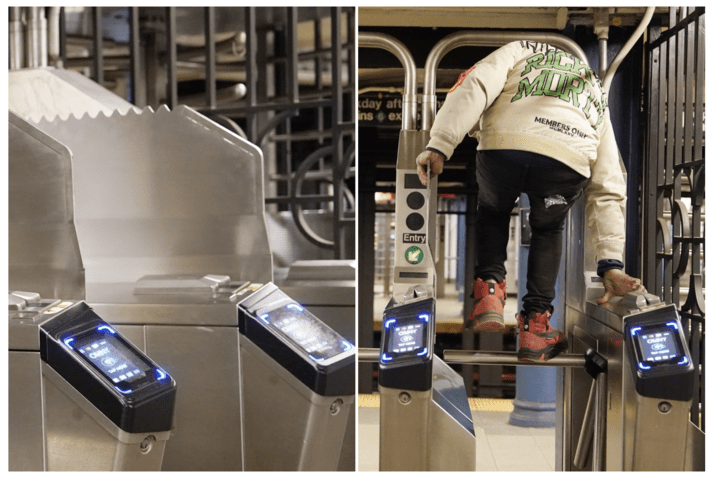The Metropolitan Transportation Authority (MTA) is facing a significant financial hemorrhage due to fare evasion, losing an estimated $800 million last year alone. Instead of implementing effective deterrence strategies, the MTA has adopted a series of demonstrably ineffective and arguably comical measures. One recent example is the installation of “spiked” metal sheets atop turnstiles, intended to prevent individuals from vaulting over the barriers. These “spikes,” however, resemble scalloped ridges and have proven entirely inadequate, with individuals readily bypassing them, highlighting the futility of this approach. This follows other failed attempts, such as the $700,000 experimental gates easily circumvented with a simple hand swipe. These repeated failures underscore a lack of seriousness in addressing the issue. The MTA’s response appears to be characterized by a cycle of expensive experimentation with ineffective solutions, followed by admissions of inadequacy and promises of further experimentation, a pattern that ultimately yields no tangible results and wastes taxpayer money.
The fundamental issue lies in the reluctance to enforce existing laws against fare evasion. While the MTA grapples with ineffective physical deterrents, a straightforward solution remains readily available: arresting fare evaders. This option, however, has been effectively decriminalized since 2020 due to the prevailing political climate. Lawmakers and progressive district attorneys have deemed enforcing fare evasion laws as biased, resulting in a drastic reduction in arrests. This policy shift has created an environment of impunity, encouraging fare evasion and emboldening those who disregard the law. The unwillingness to enforce basic regulations undermines the rule of law and ultimately penalizes law-abiding citizens who must bear the financial burden of the MTA’s losses. The irony is palpable: the city invests in elaborate and ineffective deterrents while simultaneously refusing to enforce the very laws designed to address the problem.
The financial consequences of this inaction are borne by the law-abiding public. To compensate for the revenue lost to fare evasion, the MTA is forced to increase fares for all riders and implement new taxes, such as the congestion pricing plan which further burdens drivers and indirectly affects consumers through increased delivery fees and higher food prices. These measures disproportionately impact those who diligently pay their fares and contribute to the city’s economy. The situation exemplifies a perverse incentive structure where lawbreakers are effectively rewarded with free rides while law-abiding citizens are penalized with increased costs. The city’s purported commitment to equity is undermined by this implicit subsidy for fare evaders, financed by those who dutifully adhere to the rules.
New York City prides itself on being a hub of innovation and problem-solving, yet its approach to fare evasion reveals a stark disconnect between rhetoric and reality. The city’s current approach is characterized by a preference for symbolic measures and technological gimmicks over effective enforcement of existing laws. The unwillingness to address the root cause of the problem—the widespread disregard for fare payment enabled by a lack of enforcement—undermines the city’s claim to effective governance. This failure to address a relatively straightforward issue raises concerns about the city’s capacity to tackle more complex challenges. The situation suggests a decline in the city’s ability to effectively manage basic civic functions and enforce fundamental rules, a trend that threatens the overall quality of life and erodes public trust in institutions.
The widespread fare evasion reflects a broader cultural shift towards indifference and a decline in civic responsibility. The city’s pre-pandemic slide into disorder has been exacerbated by the pandemic and further fueled by a perceived lack of focus on quality-of-life issues by city leadership. The prioritization of social justice initiatives over addressing basic civic issues like fare evasion reinforces a sense of lawlessness and contributes to the erosion of social order. The normalization of fare evasion signals a broader societal acceptance of rule-breaking, which can have cascading effects on other aspects of civic life. When basic regulations are not enforced, it fosters an environment where disregard for the law becomes increasingly commonplace, eroding the social fabric and undermining the sense of shared responsibility essential for a functioning society.
The current state of affairs in New York City represents a stark contrast to its historical image as a bastion of order and safety. The rise in fare evasion and the city’s ineffective response symbolize a decline in civic responsibility and a shift towards a low-trust environment. Superficial solutions like flimsy metal barriers are no substitute for addressing the underlying cultural issues and enforcing existing laws. Rebuilding trust and restoring order requires a fundamental shift in approach, prioritizing effective enforcement of basic rules and fostering a culture of accountability. The city must move beyond symbolic gestures and address the root causes of the problem if it hopes to regain its reputation as a well-managed and safe metropolis. The current trajectory, however, suggests a continuing decline in civic order and a deepening of the trust deficit between citizens and their governing institutions.

